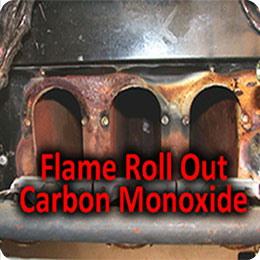Most forced air furnaces have open heat exchangers. An open heat exchanger is where you can actually see the flames, the pilot and the burners burning gas. Sometimes these are natural draft and sometimes they are induced draft. An induced draft furnace is one that has a separate small blower motor for exhausting the products of combustion, carbon monoxide, moisture and more, to the outside of the home.
When the main blower motor turns on it pulls air through the return air chamber under the furnace and this creates a vacuum. If there are any openings between the return air chamber and the closet where the open burners are located the gas company will flag the installation as dangerous.
The reason that this is a dangerous situation is because the vent for the furnace is open to the outside air through the furnace vent stack and usually up through the roof. If the main blower assembly is allowed to create a vacuum in the closet where the burner chamber is located the flames and products of combustion can reverse course and be drawn into the cabinet instead of being exhausted out the roof.
This reversing of the combustion gases can allow carbon monoxide to build up in the home and can actually pull the flames out of the firebox and cause a fire in the furnace where the gas valve and controls are. This is extremely dangerous.
Cracks in and around the base of the furnace, usually first diagnosed by the gas company, are not the same as a cracks in the firebox or cracks in the heat exchanger. To repair these base cracks and penetrations we merely need to plug the holes and cracks with a latex lagging adhesive or duct sealing compound. This can usually be performed on a simple service call.

The furnace to the left is a typical picture of what happens when the flames inside a heat exchanger on an open burner design furnace leave the firebox.
There are a variety of reasons why the fire will leave the confines of the heat exchanger. All of the reasons relate to a malfunction and nearly all of them are from a lack of regular maintenance.
Did you know that natural gas flames burn at a temperature right around 3000 degrees fahrenheit?